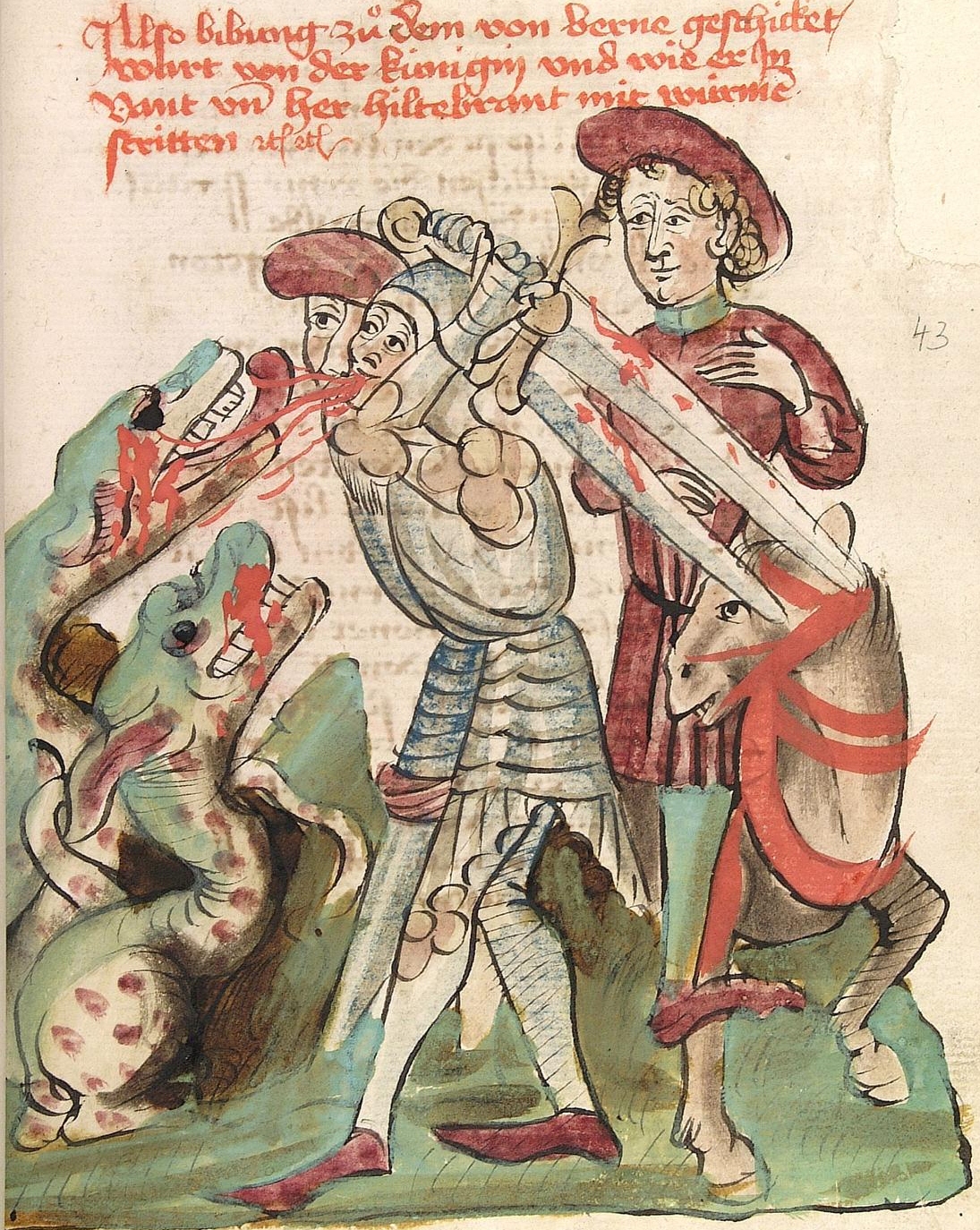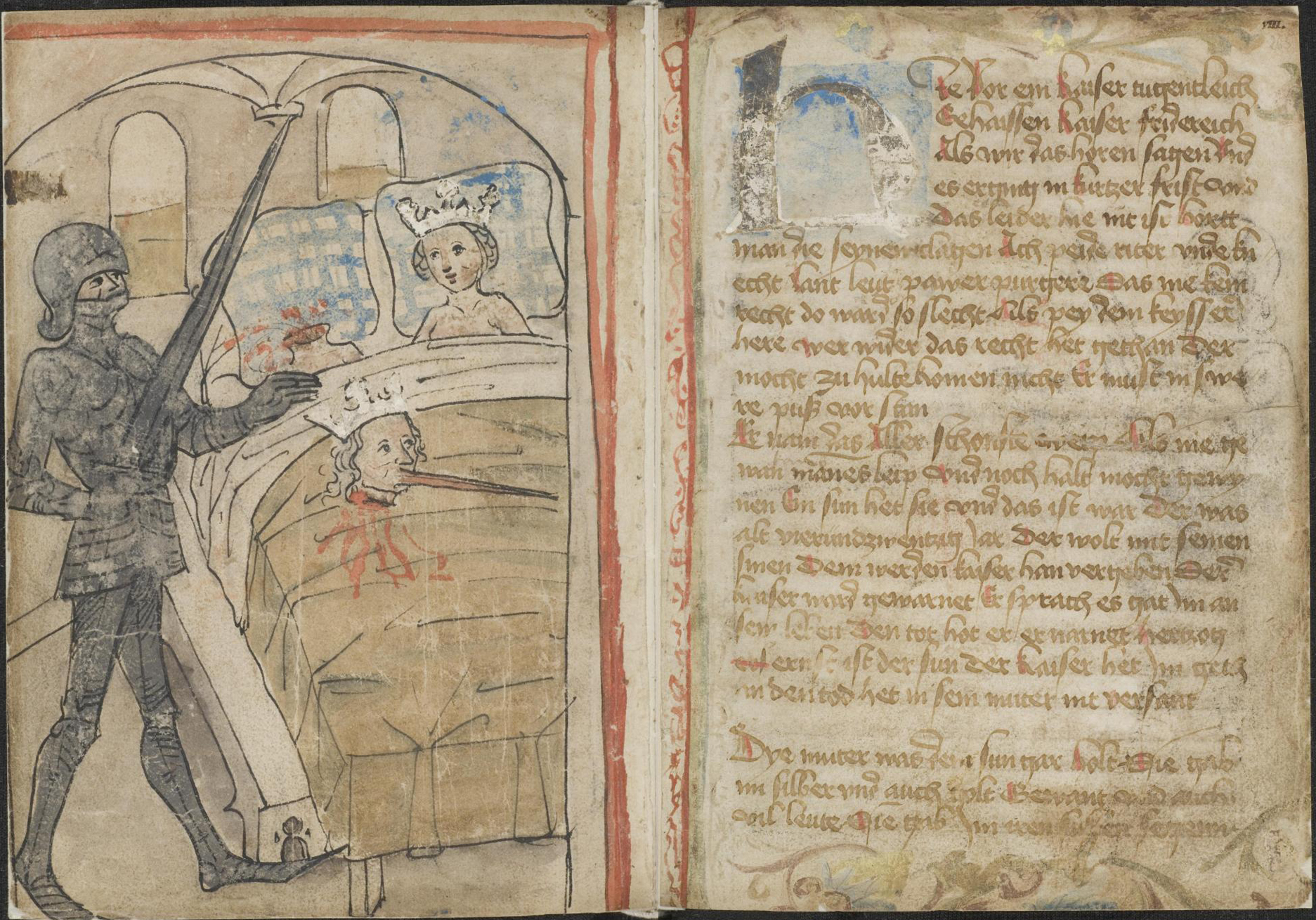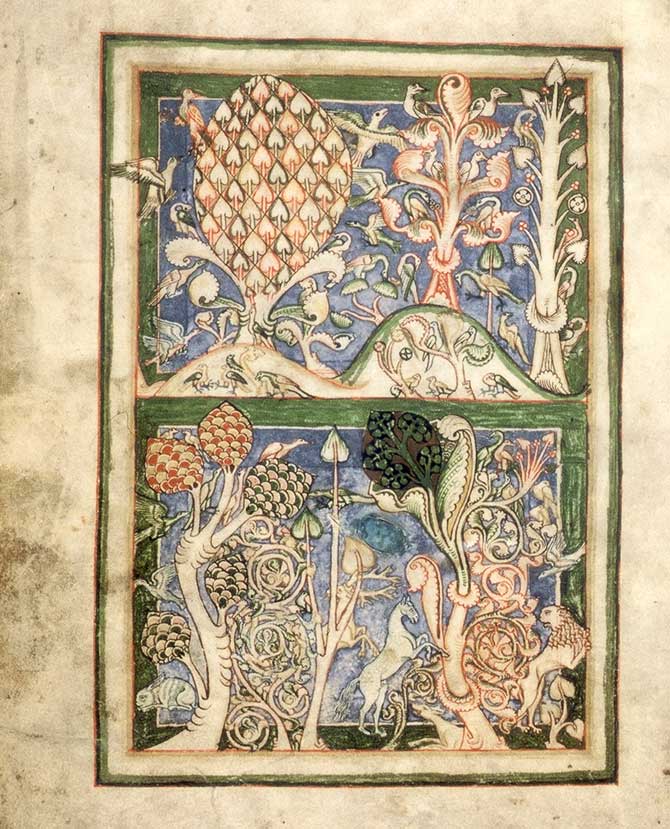|
Eckenlied
''Das Eckenlied'' or ''Ecken Ausfahrt'' (The Song of Ecke or Ecke's Quest) is an anonymous 13th-century Middle High German poem about the legendary hero Dietrich von Bern, the counterpart of the historical Ostrogothic king Theodoric the Great in Germanic heroic legend. It is one of the so-called fantastical (''aventiurehaft'') Dietrich poems, so called because it more closely resembles a courtly romance than a heroic epic. The ''Eckenlied'' tells the story of Dietrich's fight against the giant Ecke, who has been sent out by three queens to fetch Dietrich. Dietrich is forced to kill Ecke, after which he must fight Ecke's family, particularly Ecke's treacherous and vengeful brother Fasold. The poem exists in at least three separate but closely related versions, which offer different endings to the tale. A fragmentary text known as ''Dietrich und Fasold'' may represent another version of the ''Eckenlied'', but differences in meter and content make this uncertain. Fasold and the three ... [...More Info...] [...Related Items...] OR: [Wikipedia] [Google] [Baidu] |
Sigenot
''Sigenot'' is an anonymous Middle High German poem about the legendary hero Dietrich von Bern, the counterpart of the historical Ostrogothic king Theodoric the Great in Germanic heroic legend. It is one of the so-called fantastical (''aventiurehaft'') Dietrich poems, so called because it more closely resembles a courtly romance than a heroic epic. It was likely written in the Alemannic dialect area, no later than 1300. The poem concerns Dietrich's fight with the eponymous giant Sigenot, who defeats Dietrich and takes him prisoner. Dietrich must be rescued by his mentor Hildebrand, who himself is defeated by the giant but manages to escape with the help of the dwarf Eggerich and kill the giant. The ''Sigenot'' exists in two principle versions. It was by far the most popular of all Dietrich poems, being transmitted in eight extant manuscripts and twenty-one printings until 1661. It inspired various artistic depictions as well. It is nevertheless not regarded very highly as a work o ... [...More Info...] [...Related Items...] OR: [Wikipedia] [Google] [Baidu] |
Dietrich Von Bern
Dietrich von Bern is the name of a character in Germanic heroic legend who originated as a legendary version of the Ostrogothic king Theodoric the Great. The name "Dietrich", meaning "Ruler of the People", is a form of the Germanic name "Theodoric". In the legends, Dietrich is a king ruling from Verona (Bern) who was forced into exile with the Huns under Etzel by his evil uncle Ermenrich. The differences between the known life of Theodoric and the picture of Dietrich in the surviving legends are usually attributed to a long-standing oral tradition that continued into the sixteenth century. Most notably, Theodoric was an invader rather than the rightful king of Italy and was born shortly after the death of Attila and a hundred years after the death of the historical Gothic king Ermanaric. Differences between Dietrich and Theodoric were already noted in the Early Middle Ages and led to a long-standing criticism of the oral tradition as false. Legends about Theodoric may have exi ... [...More Info...] [...Related Items...] OR: [Wikipedia] [Google] [Baidu] |
Goldemar
''Goldemar'' is a fragmentary thirteenth-century Middle High German poem by Albrecht von Kemenaten about the legendary hero Dietrich von Bern, the counterpart of the historical Ostrogothic king Theodoric the Great in Germanic heroic legend. It is one of the so-called fantastical (''aventiurehaft'') Dietrich poems, so called because it more closely resembles a courtly romance than a heroic epic. The poem concerns Dietrich's fight with the dwarf king Goldemar after he sees the dwarf absconding with a princess. It is the only poem in the tradition of Germanic heroic poetry with a named author that is accepted as genuine. Summary Only the first nine stanzas of the ''Goldemar'' have survived. They tell that Dietrich once set off into the forest to defeat the giants who live in Trutmunt forest. While on this quest, he comes across a mountain where dwarfs make their home. He notices that the dwarfs have a girl with them, and immediately falls in love. The dwarfs attempt to hide the gi ... [...More Info...] [...Related Items...] OR: [Wikipedia] [Google] [Baidu] |
Heldenbuch
''Heldenbücher'' (singular ''Heldenbuch'' "book of heroes") is the conventional title under which a group of German manuscripts and prints of the 15th and 16th centuries has come down to us. Each ''Heldenbuch'' contains a collection of primarily epic poetry, typically including material from the Theodoric cycle, and the cycle of Hugdietrich, Wolfdietrich and Ortnit. The ''Heldenbuch'' texts are thus based on medieval German literature, but adapted to the tastes of the Renaissance. Manuscripts The earliest surviving Heldenbuch is a parchment manuscript dating from the first half of the 14th century, which survived only in five fragments (two are now missing). It is variously referred to as the Rheinfränkisches Heldenbuch ("Rhine Franconian Heldenbuch") from its dialect or the ''Berlin-Wolfenbüttel Heldenbuch'' from the location of two of the fragments, and preserves parts of the Eckenlied (E3), Virginal (V3), Ortnit (C) and Wolfdietrich (C), though the fragments do not give any ... [...More Info...] [...Related Items...] OR: [Wikipedia] [Google] [Baidu] |
Germanic Heroic Legend
Germanic heroic legend (german: germanische Heldensage) is the heroic literary tradition of the Germanic-speaking peoples, most of which originates or is set in the Migration Period (4th-6th centuries AD). Stories from this time period, to which others were added later, were transmitted orally, traveled widely among the Germanic speaking peoples, and were known in many variants. These legends typically reworked historical events or personages in the manner of oral poetry, forming a heroic age. Heroes in these legends often display a heroic ethos emphasizing honor, glory, and loyalty above other concerns. Like Germanic mythology, heroic legend is a genre of Germanic folklore. Heroic legends are attested in Anglo-Saxon England, medieval Scandinavia, and medieval Germany. Many take the form of Germanic heroic poetry (german: germanische Heldendichtung): shorter pieces are known as heroic lays, whereas longer pieces are called Germanic heroic epic (). The early Middle Ages preser ... [...More Info...] [...Related Items...] OR: [Wikipedia] [Google] [Baidu] |
Carmina Burana
''Carmina Burana'' (, Latin for "Songs from Benediktbeuern" 'Buria'' in Latin is a manuscript of 254 poems and dramatic texts mostly from the 11th or 12th century, although some are from the 13th century. The pieces are mostly bawdy, irreverent, and satirical. They were written principally in Medieval Latin, a few in Middle High German and old Arpitan. Some are macaronic, a mixture of Latin and German or French vernacular. They were written by students and clergy when Latin was the lingua franca throughout Italy and western Europe for travelling scholars, universities, and theologians. Most of the poems and songs appear to be the work of Goliards, clergy (mostly students) who satirized the Catholic Church. The collection preserves the works of a number of poets, including Peter of Blois, Walter of Châtillon and an anonymous poet referred to as the Archpoet. The collection was found in 1803 in the Benedictine monastery of Benediktbeuern, Bavaria, and is now housed in the Bava ... [...More Info...] [...Related Items...] OR: [Wikipedia] [Google] [Baidu] |
Codex Buranus
''Carmina Burana'' (, Latin for "Songs from Benediktbeuern" 'Buria'' in Latin is a manuscript of 254 poems and dramatic texts mostly from the 11th or 12th century, although some are from the 13th century. The pieces are mostly bawdy, irreverent, and satirical. They were written principally in Medieval Latin, a few in Middle High German and old Arpitan. Some are macaronic, a mixture of Latin and German or French vernacular. They were written by students and clergy when Latin was the lingua franca throughout Italy and western Europe for travelling scholars, universities, and theologians. Most of the poems and songs appear to be the work of Goliards, clergy (mostly students) who satirized the Catholic Church. The collection preserves the works of a number of poets, including Peter of Blois, Walter of Châtillon and an anonymous poet referred to as the Archpoet. The collection was found in 1803 in the Benedictine monastery of Benediktbeuern, Bavaria, and is now housed in the Bava ... [...More Info...] [...Related Items...] OR: [Wikipedia] [Google] [Baidu] |
Emperor Zeno
Zeno (; grc-gre, Ζήνων, Zénōn; c. 425 – 9 April 491) was Eastern Roman emperor from 474 to 475 and again from 476 to 491. Domestic revolts and religious dissension plagued his reign, which nevertheless succeeded to some extent in foreign issues. His reign saw the end of the Western Roman Empire following the deposition of Romulus Augustus and the death of Julius Nepos, but he was credited with contributing much to stabilising the Eastern Empire. In ecclesiastical history, Zeno is associated with the '' Henotikon'' or "instrument of union", promulgated by him and signed by all the Eastern bishops, with the design of solving the monophysite controversy. The Henotikon was widely unpopular and eventually abandoned under Justin I. Biography Rise to power Early life Zeno's original name was Tarasis, and more accurately ''Tarasikodissa'' in his native Isaurian language ( la, Trascalissaeus).The sources call him "Tarasicodissa Rousombladadiotes", and for this reason ... [...More Info...] [...Related Items...] OR: [Wikipedia] [Google] [Baidu] |
Witege
Witege, Witige or Wittich ( ang, Wudga, Widia; Gotho- lat, Vidigoia) or Vidrik "Vidga" Verlandsson ( + ''Viðga'' or ''Videke'' + ''Verlandsson'', ''Vallandsson'', or ''Villandsson'') is a character in several Germanic heroic legends, poems about Dietrich von Bern, and later Scandinavian ballads.The article Vidrik Verlandsson' in ''Nordisk familjebok'' (1921). In German legends, he was one of the warriors of Dietrich von Bern, but betrayed him and took instead the side of his wicked Uncle Ermenrich. In one of the Scandinavian ballads (TSB E 119), he won particular fame in his duel with Langben Rese/Risker (the giant Etgeir in the '' Þiðrekssaga''). During the Middle Ages, he became the son of Wayland the Smith and Böðvildr, and this entitled him to carry a hammer and tongs in his coat of arms. Later the origin of his name "Wayland's son" was forgotten, but the fame of the character prevailed. During the 16th and the 17th centuries, this led to the idea that his name " ... [...More Info...] [...Related Items...] OR: [Wikipedia] [Google] [Baidu] |
Attila The Hun
Attila (, ; ), frequently called Attila the Hun, was the ruler of the Huns from 434 until his death in March 453. He was also the leader of a tribal empire consisting of Huns, Ostrogoths, Alans, and Bulgars, among others, in Central and Eastern Europe. During his reign, he was one of the most feared enemies of the Western and Eastern Roman Empires. He crossed the Danube twice and plundered the Balkans, but was unable to take Constantinople. His unsuccessful campaign in Persia was followed in 441 by an invasion of the Eastern Roman (Byzantine) Empire, the success of which emboldened Attila to invade the West. He also attempted to conquer Roman Gaul (modern France), crossing the Rhine in 451 and marching as far as Aurelianum (Orléans), before being stopped in the Battle of the Catalaunian Plains. He subsequently invaded Italy, devastating the northern provinces, but was unable to take Rome. He planned for further campaigns against the Romans, but died in 453. After Attila' ... [...More Info...] [...Related Items...] OR: [Wikipedia] [Google] [Baidu] |
Rabenschlacht
''Die Rabenschlacht'' (The Battle of Ravenna) is an anonymous 13th-century Middle High German poem about the hero Dietrich von Bern, the counterpart of the historical Ostrogothic king Theodoric the Great in Germanic heroic legend. It is part of the so-called "historical" Dietrich material and is closely related to, and always transmitted together with, a second Dietrich poem, ''Dietrichs Flucht''. At one time, both poems were thought to have the same author, possibly a certain Heinrich der Vogler, but stylistic differences have led more recent scholarship to abandon this idea. ''Die Rabenschlacht'' concerns a failed attempt by the exiled Dietrich to reclaim his kingdom in Northern Italy from his treacherous uncle Ermenrich, with the help of an army provided by Etzel, king of the Huns. In the course of this attempt, Dietrich's younger brother and Etzel's young sons by his wife Helche are killed by Dietrich's former vassal Witege outside of Ravenna. Witege then flees into the sea ... [...More Info...] [...Related Items...] OR: [Wikipedia] [Google] [Baidu] |
Metaliterature
Metafiction is a form of fiction which emphasises its own narrative structure in a way that continually reminds the audience that they are reading or viewing a fictional work. Metafiction is self-conscious about language, literary form, and story-telling, and works of metafiction directly or indirectly draw attention to their status as artifacts. Metafiction is frequently used as a form of parody or a tool to undermine literary conventions and explore the relationship between literature and reality, life, and art. Although metafiction is most commonly associated with postmodern literature that developed in the mid-20th century, its use can be traced back to much earlier works of fiction, such as '' The Canterbury Tales'' ( Geoffrey Chaucer, 1387), ''Don Quixote'' (Miguel de Cervantes, 1605), ''The Life and Opinions of Tristram Shandy, Gentleman'' (Laurence Sterne, 1759), and '' Vanity Fair'' (William Makepeace Thackeray, 1847). Metafiction became particularly prominent in the 1 ... [...More Info...] [...Related Items...] OR: [Wikipedia] [Google] [Baidu] |











